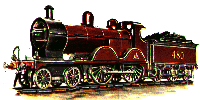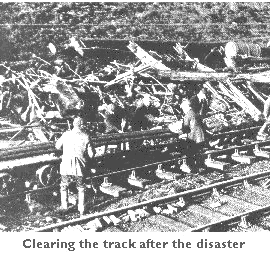


Accidents

Currents

Features

Gallery

Books

Links

Site Map

Help

Search

Bibliography

Glossary


Hawes Junction - 1910

Summary
 Hawes Junction, 24 December 1910. In the early hours of that morning the London to Glasgow sleeping car express ran into the back of two light-engines. They had completed duties as pilot engines to trains facing the "long drag" up Ais Gill and were returning to Carlisle.
Hawes Junction, 24 December 1910. In the early hours of that morning the London to Glasgow sleeping car express ran into the back of two light-engines. They had completed duties as pilot engines to trains facing the "long drag" up Ais Gill and were returning to Carlisle.They had been moved onto the main line and were awaiting the signal to return to their base. The busy signalman forgot that they were there. When he pulled-off the signal for the approaching special express, they assumed that the signal was meant for them and commenced their run back down the bank. They had not gone far (less than 1.5 miles) and were still accelerating when the fireman in the rear locomotive turned to look behind. He saw the approaching train, the midnight sleeping car express from London St Pancras to Glasgow. Travelling northwards at some 65 mph it soon caught up with and smashed into the rearmost engine.
The resulting collision was not so severe, although there was some telescoping of the coaches. However two of the coaches caught fire due to the escape of compressd oil gas, used for lighting. The death toll was 12 several of whom were trapped in the wreckage, unable to extricate themselves before the fire reached them.
 The "small engine policy" introduced on the Midland Railway in the early part of the 20th Century resulted in that company running frequent light trains rather than a few heavy trains. However it was frequently the case that the motive power available was insuficient to handle even these trains over some of the gradients prevalent on the system. Nowhere was this more true than on the very heavily graded Settle - Carlisle line. This was the Midland's main-line to Scotland and the scene of much banking and double-heading of trains.
The "small engine policy" introduced on the Midland Railway in the early part of the 20th Century resulted in that company running frequent light trains rather than a few heavy trains. However it was frequently the case that the motive power available was insuficient to handle even these trains over some of the gradients prevalent on the system. Nowhere was this more true than on the very heavily graded Settle - Carlisle line. This was the Midland's main-line to Scotland and the scene of much banking and double-heading of trains.The night of 23 December 1910 at Hawes Junction was a foul one. Trains battled against the strong "Helm" wind and driving rain made the rail slippery. Signalman Alfred Sutton, on duty at the Hawes Junction Signal Box was nearing the end of his shift. Additional trains had been laid on to cope with the holiday traffic. Pilot locomotives working in either direction were detached at Aisgill summit, then proceeded to Hawes Junction to be turned on the turntable there before returning to their starting points, Carlisle, Leeds or Hellifield. At the time of his fatal mistake, Sutton had nine locomotives under his control each of which he was anxious to dispatch to their starting points.
The scale of the operation at Hawes may be judged from the signal box log. It clearly shows the amount of traffic that was being dealt with, the complexity of the operation and the signalman's preoccupation with the movement of light engines. The signalbox itself was situated midway on the Down platform of Hawes Junction Station (now called Garsdale). It had only been brought into use some six months earlier, replacing two old signalboxes.
| 4.6am | engines 548 and 448 arrived from Aisgill |
| 4.14am | down express passed; engines 548 and 448 were then turned and parked in the branch platform line | 4.36am | engines247, 249, 313 and 314 arrived from Aisgill coupled together |
| 4.41am | down "fitted" goods passed; engines 247, 249, 313 and 314 were then crossed to the turntable road |
| 4.47am | engines 317, 312 and 42 arrived from Aisgill, coupled together and were crossed to the turntable road |
| 4.49am | up through goods passed |
| 5.20am | down special express passed |
After the movement of engines 448 and 548 and while he awaited clearance from Aisgill the signalman became busy with several other matters. Three more locomotives were ready to depart, another goods train was expected, a telephone call concerning locomotives due to return to Hellifield and an engineman needed to send a message concerning his relief.
Sutton had nothing to remind him that the two engines were still waiting for the signal. Collars, which by placing one over the appropriate signal lever, a signalman could be reminded of trains waiting, were not issued. Track circuiting was still not widely implemented at that time. If either of these precautionary measures had been in place, the error that Sutton was about to make would not have occurred.
Meanwhile the locomotives waited. Neither of the drivers thought to attract the signalman's attention despite the fact that they had been standing for a considerable time. Nor did they send one of the firemen to the signalbox to inform the signalman that they were still awaiting their signal. This was in direct contravention of Rule 55 which requires such an action after a train has been held at a signal for 5 minutes. They in fact stood for 23 minutes.
The scene was now set for the Sutton's fatal mistake on that Christmas Eve morning. At 5.26am he received the "Train out of section" bell code from Aisgill. His response should have been to send "Is line clear" to Ais Gill in order to be able to send engines 448 and 548 on their way. However, after dealing with two Up goods trains, he was offered and accepted the Down midnight express at 5.35am. The "Train entering section" bell code was received at 5.43. He sent "Is line clear" to Dent who accepted it. He then cleared the signals for the express.
 Below, engines 448 and 548 saw the signal pulled-off and began their journey back to Carlisle. Four minutes later, at 5.47 the Down express passed Sutton's box at speed. The train consisted of eight vehicles, two of which were sleeping cars. The express was headed by engine 549 and piloted by a Kirtley 2-4-0 No 48. Fifty-six passengers were travelling that night, seventeen of whom were in the sleeping cars. As the express caught up with the engines ahead, the almost inevitable collision might still have been averted had the driver seen the tail light on the rearmost engine. However, a short tunnel obstructed his view and the the swirling rain and mist made forward vision difficult.
Below, engines 448 and 548 saw the signal pulled-off and began their journey back to Carlisle. Four minutes later, at 5.47 the Down express passed Sutton's box at speed. The train consisted of eight vehicles, two of which were sleeping cars. The express was headed by engine 549 and piloted by a Kirtley 2-4-0 No 48. Fifty-six passengers were travelling that night, seventeen of whom were in the sleeping cars. As the express caught up with the engines ahead, the almost inevitable collision might still have been averted had the driver seen the tail light on the rearmost engine. However, a short tunnel obstructed his view and the the swirling rain and mist made forward vision difficult.It was not until 5.48 when another driver came into the signalbox that Alfred Sutton remembered the two engines. It was of course, by then too late. The express had passed 8 minutes earlier and no "Train out of section" signal had been received from Ais Gill. At the change of shift at 6.00am Sutton told his relief "Will you go to Stationmaster Bunce and say that I am afraid that I have wrecked the Scotch express?"
The impact had been quite severe. The light engines had only gone 1.5 miles and were travelling at about 30 mph when they were struck by the express. Seven of the passenger vehicles had been derailed and the first and second coaches had telescoped. The express engines were also derailed. Although the damage, in absolute terms was relatively light, fire eventually destroyed six of the coaches. They were lit by pressurised oil gas and one of the gas pipes had fractured. The resulting ecape of gas ignited and the timber-built carriages were soon alight. Passengers on the train could do little to tackle the fire with the meagre equipment available. Despite valiant attempts to reach passengers trapped in the wreckage, the would-be rescuers were beaten back by the rapidly spreading flames. A number of these passengers were still conscious when the fire reached them. The final death toll was twelve, all of whom had been in the first two coaches.
Disasters at Christmas in the Twentieth Century
 Top
Top
 Contents | Index of Articles | Recent Reports | Post Office | Links | Site Map | Guestbook | E-mail
Contents | Index of Articles | Recent Reports | Post Office | Links | Site Map | Guestbook | E-mail


